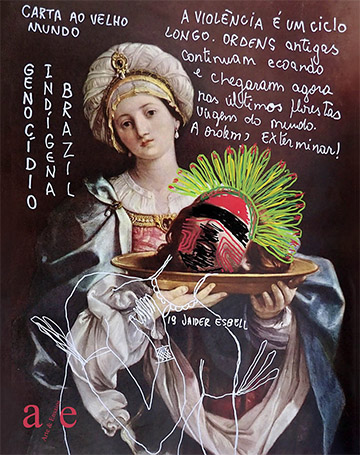DO HABITAT NATURAL AO SISTEMA DA ARTE: O CORPO DO ANIMAL COMO EVIDÊNCIA DO COMPLEXO DE MUDANÇAS DO MUNDO / From natural habitat to the art system: the animal’s body as evidence of a changing world
DOI :
https://doi.org/10.37235/ae.n41.12Résumé
Este artigo situa de que maneira o animal – reconfigurado na forma de objeto de arte – pode ser tomado como evidência do continuum de mudanças que forjaram o mundo. A reprodução “artística” das espécies acompanha o percurso da própria humanidade, e, nos dias de hoje, sua presença estimula novas incumbências para a arte. Obras com essa especificidade têm sido capazes de acionar uma série de problemas de múltiplas conformações, sobretudo, quando os liames de humanos e animais se encontram no foco de instâncias diversificadas. Acompanhando a trajetória desses seres do habitat natural até sua recepção em espaços certificados, vê-se que, no mesmo rumo dos demais artefatos apropriados pelos artistas, trabalhos contendo animais podem ser considerados eminentes para o sistema da arte, a história da arte e a história do mundo.
Palavras-chave: Animal na arte; Objetos de arte; História da arte; Arte contemporânea.
Abstract
This article situates in what way the animal – reconfigured in the form of an art object – can be taken as evidence of the continuum of changes that forged the world. The “artistic” reproduction of species follows the path of humanity itself and, nowadays, its presence stimulates new tasks for art. Works with this specificity have been able to trigger a series of problems with multiple conformations, especially when the links between humans and animals are the focus of diversified instances. Following the trajectory of these beings from their natural habitat to their reception in certified spaces, one can see that, in the same course as other artifacts appropriated by artists, works containing animals can be considered eminent for the art system, the art history and the history of the world.
Keywords: Animal in art; Art objects; Art history; Contemporary art.
Références
AMARAL, Aracy A. Arte num período difícil (1964-c.1980). In: AMARAL, Aracy A. Textos do Trópico de Capricórnio: artigos e ensaios (1980-2005). Vol. 1: Modernismo, arte moderna e o compromisso com o lugar. São Paulo: Ed. 34, 2006.
BERGER, John. Why look at animals? In: BERGER, John. About looking. London: Bloomsbury, 2009.
CANTON, Katia. Alex Flemming, uma poética... São Paulo: Metalivros, 2002.
CHAIA, Miguel. Artivismo – política e arte hoje. Aurora, São Paulo, v. 1, p. 9-11, 2007.
FOSTER, Hal. O retorno do real: a vanguarda no final do século XX. São Paulo: Cosac Naify, 2014.
HICKMANN, Juliana Copetti. Animais em arte e representação: dos retratos às instalações. Revista-Valise. Porto Alegre, ano 3, v. 3, n. 6, dez. 2013.
Disponível em: https://seer.ufrgs.br/ RevistaValise/article/view/41797/28113. Acesso em dez. 2018.
HUGHES, Robert. American visions: the epic history of art in America. New York: Alfred A. Knopf,1997.
LIMA, Joana D’Arc de Sousa. A arte e seu entrecruzamento com a política: arte-guerrilha, 1969-1971. Idéias, Campinas, ano 12 (1), 2005.
MACIEL, Maria Esther. Prólogo. In: MACIEL, Maria Esther (org.). Pensar/escrever o animal: ensaios de zoopoética e biopolítica. Florianópolis: Editora UFSC, 2011.
MALTA, Marize. Imortal enquanto dure... animais, taxidermia e objetos do mal na arte. 25o Encontro Nacional da Anpap – Associação Nacional de Pesquisadores em Artes Plásticas, Anais... Porto Alegre, 2016, p. 2159-2174. Disponível em: http://anpap.org.br/anais/2016/ simposios/s1/marize_malta.pdf. Acesso em dez. 2018.
MORAIS, Frederico. Frederico Morais. Org. Silvana Seffrin. Rio de Janeiro: Funarte, 2004.
MORAIS, Frederico. Crônicas de amor à arte. Rio de Janeiro: Revan, 1995.
SHIPPEY, Tom. Throw your testicles. London Review of Books, v. 41, n. 24, 19 dez. 2019. Disponível em: https://www.lrb.co.uk/the-paper/v41/n24/tom-shippey/throw-your-testicles. Acesso em dez. 2019.
Téléchargements
Publiée
Numéro
Rubrique
Licence
Autores que publicam nesta revista concordam com os seguintes termos:- Autores mantém os direitos autorais e concedem à revista o direito de primeira publicação, com o trabalho simultaneamente licenciado sob a Licença Creative Commons Attribution que permite o compartilhamento do trabalho com reconhecimento da autoria e publicação inicial nesta revista.
- Autores têm autorização para assumir contratos adicionais separadamente, para distribuição não-exclusiva da versão do trabalho publicada nesta revista (ex.: publicar em repositório institucional ou como capítulo de livro), com reconhecimento de autoria e publicação inicial nesta revista.
- Autores têm permissão e são estimulados a publicar e distribuir seu trabalho online (ex.: em repositórios institucionais ou na sua página pessoal) a qualquer ponto antes ou durante o processo editorial, já que isso pode gerar alterações produtivas, bem como aumentar o impacto e a citação do trabalho publicado (Veja O Efeito do Acesso Livre).


